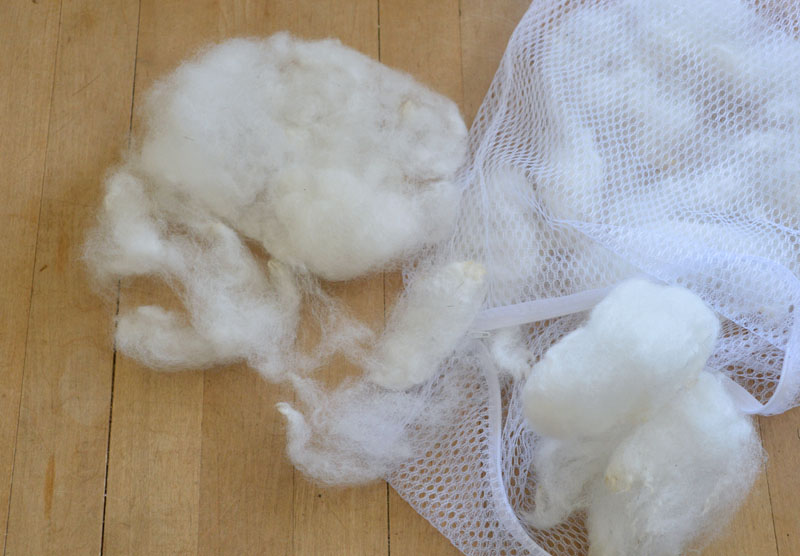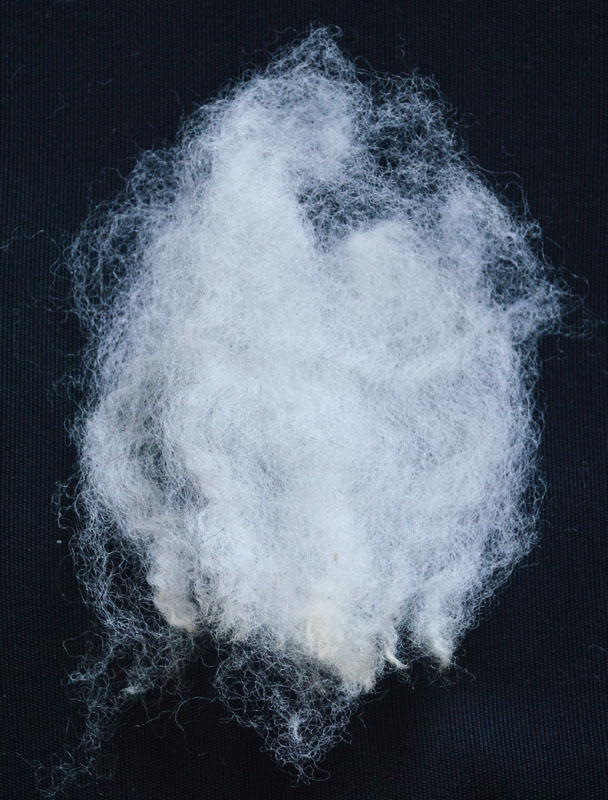
What I actually did though, was exercise some restraint (a minor miracle for me), and decided that I better do some test scouring first since, you know, I had no idea what I was actually doing with this whole raw fleece processing thing.
The first thing I did was test the temperature of my water at its highest point (just turning the hot tap on and letting the bucket fill). From everything I read lanolin loosens at around the 45C mark, and I wanted to make sure my water was hot enough. Thankfully, my water was at 50.2C coming out of the tap so I was good to go. Normally I don’t mind yarn with a bit of lanolin in it, but I have plans to do natural dyeing on the yarn I spin, so all lanolin (or at least the vast majority of it) has to come out so I can get good colour coverage.

I did a total of three samples in two different washes. One batch of both breeds in Dawn, and then another batch of just the Friesian with the Orvus paste. The only thing I changed with both washes was how I actually loaded the fleece, and the soap.
The First Batch
Filling up my laundry bags with my samples was kind of a mess. I just took some handfuls and shoved them in without much thought as to keeping the locks nice and organized. My mistake – and I’ll talk about that a bit more below.
I filled my tubs with about 8L of water, squirted about half a cup of Dawn in, and then very carefully mixed it in, trying to prevent as much sudsing as I could (still got a lot of suds though, which I found frustrating when it came to rinsing). I let the samples sit in the water for about 15 minutes, dumped the water, filled up again with the same amount of water and soap, and did another scour (again for 15 minutes with about half a cup of Dawn in 8L of water)
After the second wash I was happy with how clean the water was. I will say here my fleeces are particularly clean – both breeds were jacketed flocks, and were skirted before getting to me, so they didn’t actually need that much hard scouring. Where most of my water usage came from was trying to get all the soap suds out. It took three additional washes of water, all at 15 minute soaks, to get the fleece suds free.
After the final rinse, I loaded them up in my washing machine and spun them dry. If you’re going to do this step make extra double sure that your machine doesn’t spray water during its spin cycle, otherwise you’ll get a felted mess.
After the spin dry, I took them out, and let them sit for less than a day and bam, I had dry clean fleece (I also live in a very dry climate, so air drying times are quite short for me as a rule).
They did have a soapy Dawn smell, which kind of covered up the natural clean sheepy smell that I love, so I wasn’t super excited about that. I know it seems like a weird thing to nit pick about, but there you have it.
The Second Batch

- 1. I used Orvus Paste; and
2. I tried to preserve the lock
For this batch I washed twice, although if I didn’t care so much about getting out all the lanolin I think one would have done it. For the first scour I used 2 tbsp of Orvus, and the second wash I used 1 tbsp, both in 8L water baths. I then rinsed twice, and followed the same path of spinning to dry.
I had read a few notes saying that the hand might be not quite as nice after washing with Orvus, but I didn’t notice a difference between Orvus and Dawn. The other bonus with the Orvus was no scent at all – what I had afterwards was a clean sheepy smell with no additional smells from the cleaning agent.
Preserving The Lock
I can tell already that this is going to be a learning curve for me. Lets face it, I’m probably not going to wash lock by lock, but I really want to preserve that structure as best I can. You can see in the second photo above in my first sample scour, without giving much thought to how you lay out your locks, you kind of get a hot mess at the end of all your washing.
So, for the second batch I laid out one layer of locks in my laundry bag, and pinned up the edges to give minimal movement to the locks while washing. It definitely worked better, but there will be more work to be done. I laid them out with the cut tips all facing in towards each other, and the outer tips facing the edges of the bag to allow maximum water movement around the dirtiest bits.
I think with more pinning, and actually putting more fleece in each bag the locks will be preserved even better.
Prepping for Spinning

I have hand carders, but no combs (which will be ratified sooner rather than later), so for the hot mess of the first wash I thought I’d trying carding my fibre.
I’m a bit out of practice with carding, so I’m not going to go too much into that here – there’ll be lots of blog posts down the line with how I’m doing that. I did card up some of the Friesian and try spinning, but I have a few other spinning projects on the go and didn’t really spend the time I should have on getting that right for spinning.
When I’m done my current spins, I’m going to focus on carding the Merino/Romney and I’ll spin up a sample, and post all about that here. Once I get my combs as well I’ll really get into the details of combing and carding and getting all that fibre prepped for spinning, and eventually dyeing.
I plan to get my tetanus booster and then go whole-hog with the washing, which is the reason why after my samples and now a good foundation of how I’m going to do this, I haven’t started washing more and more. Stay tuned for updates after I get that taken care of (can’t be too careful!) where I’ll be sharing more washing and prepping stories.
I feel like I’ve learned a ton already, and I have so much more to go. I’m finding the whole process really satisfying, and seeing through raw wool to knitted object is already proving to be a great experience for me.
Lessons Learned
- Take an extra few minutes to preserve the lock while washing to make combing easier when everything is dry.
- The dog is very useful to see if my fleece is properly cleaned – she goes nuts for the raw fleece in the garage, but if it’s cleaned enough at the end of the scouring process she’s totally disinterested.